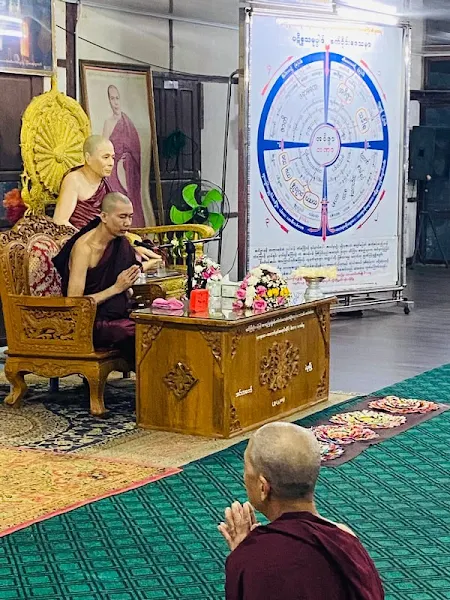Let us pay homage to the Five Infinities with joined palms, bowing with humility: Namo Buddhassa. Namo Dhammassa. Namo Sanghassa. Namo Matapitussa. Namo Acariyassa.
ဝန္ဒာမိ
ဝန္ဒာမိ စေတိယံ သဗ္ဗံ၊ သဗ္ဗဋ္ဌာနေသု ပတိဋ္ဌိတံ။ ယေ စ ဒန္တာ အတီတာ စ၊ ယေ စ ဒန္တာ အနာဂတာ၊
ပစ္စုပ္ပန္နာ စ ယေ ဒန္တာ၊ သဗ္ဗေ ဝန္ဒာမိ တေ အဟံ။
vandāmi cetiyaṃ sabbaṃ, sabbaṭṭhānesu patiṭṭhitaṃ. Ye ca dantā atītā ca, ye ca dantā anāgatā, paccuppannā ca ye dantā, sabbe vandāmi te ahaṃ.
The Buddhist path to liberation from samsara, the cycle of suffering and rebirth.
The Buddhist path to liberation from **samsara**, the cycle of suffering and rebirth.
1. The Goal:
Nibbanic Bliss
Buddhism aims to achieve **Nibbana**, a state of ultimate peace and liberation from suffering. This is attained through understanding and practicing the teachings.
2. Key Doctrines:
Five Aggregates:
These are the five components of our experience (form, feeling, perception, mental formations, and consciousness). Understanding them helps us see the impermanent and illusory nature of our experience.
Twelve Ayatanas:
These are the twelve "sense spheres" that connect us to the world (six senses, six objects). By recognizing their interconnectedness, we can break free from clinging to them.
Eighteen Dhatus:
This doctrine expands on the Twelve Ayatanas by adding six types of consciousness (visual, auditory, olfactory, gustatory, tactile, and mental). It helps us understand how our senses and consciousness interact to create our experience.
Four Noble Truths (Saccas):
These are the core truths about suffering (Dukkha), its cause (Tanha - craving), its cessation (Nirvana), and the path to its cessation (the Eightfold Path).
Law of Dependent Origination:
This principle explains the interconnectedness of all phenomena and how suffering arises from a chain of causes and conditions. By understanding this law, we can identify and break the cycle of suffering.
3. The Eightfold Path:
The Eightfold Path is the practical guide to liberation. It includes:
1. Right Understanding:
Understanding the true nature of reality and suffering.
2. Right Thought:
Cultivating positive and wholesome thoughts.
3. Right Speech: Speaking truthfully and kindly.
4. Right Action:
Acting with compassion and non-violence.
5. Right Livelihood:
Choosing a way of life that aligns with ethical principles.
6. Right Effort:
Working diligently to overcome negative tendencies.
7. Right Mindfulness:
Being aware of the present moment without judgment.
8. Right Concentration:
Developing focus and mental stability.
4. The Importance of Meditation:
Practices like **Vipassana meditation** help us see the interconnectedness of things and understand the cycle of suffering (dependent origination), ultimately leading to liberation.
5. The Cycle of Suffering:
Samsara is a cycle driven by craving, attachment, and ignorance. Through practicing the Eightfold Path and understanding the underlying principles, we can break free from this cycle and achieve true liberation.
In essence:
Buddhism offers a structured path to escape the endless cycle of suffering through self-awareness, ethical conduct, and mental discipline. This path leads to liberation, freeing us from the grip of samsara and reaching a state of lasting peace and enlightenment.
Sao Dhammasami
Ph.D (Candidate) ,M.A,B.A(Pali),Master Trainer (EIU)
The International Buddhist Studies College,MCU


